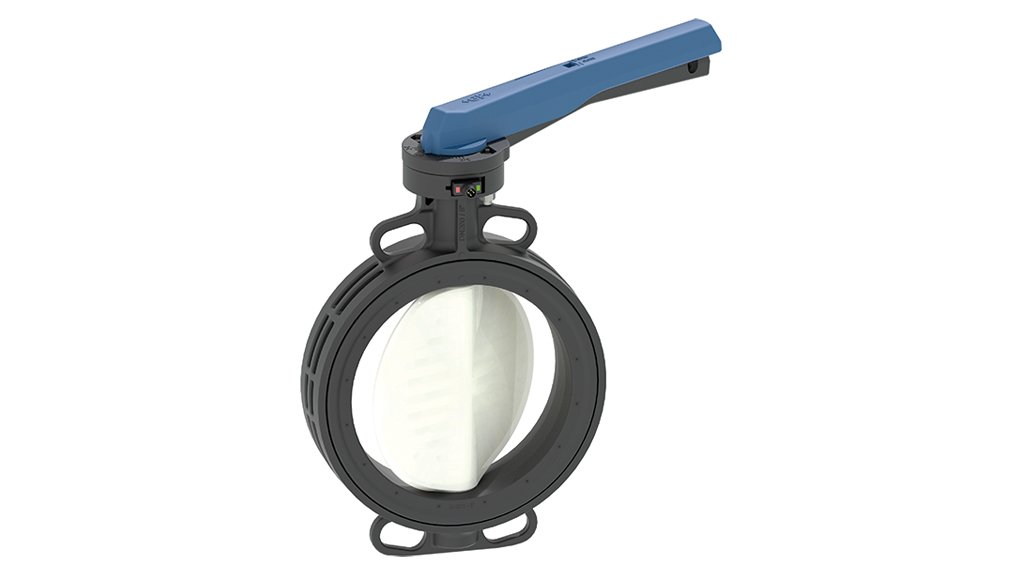Manufacturing company GF Piping Systems launched its plastic butterfly valve 565 in April at its headquarters in Schaffhausen, Switzerland.
The 565 valves, manufactured in Seewis im Prättigau, Switzerland, arrived in South Africa on July 1.
To date, the valves have been installed at mining sites in Gauteng, the North West and the Northern Cape, says South African industrial equipment supplier Instru-Serve project manager Kevin Lindsay, who adds that the manufacturing process takes only about ten days, as some semi-finished components are readily available in South Africa.
GF Piping Systems also produces single components and buys other components that it assembles to manufacture the butterfly valve.
“Most of the valves are in stock, so if a customer needs ten or 50 valves, the valves would be flown out on a Friday and arrive in South Africa over the weekend. I would clear the valves by the Monday and the customer would receive the valves on the Tuesday.
“We're dealing with demand on a project-by- project basis currently and building up stock as we go,” he says.
Lindsay says the plastic butterfly valve 565 design has the same footprint as the design of the steel valves, consequently allowing it to compete with steel valves, and that GF has always manufactured butterfly valves in various plastics, including unplasticised polyvinyl chloride, or PVC-U, and polyvinylidene fluoride, or PVDF.
Further, the valves do not corrode because plastic cannot rust and the seating of the disk of the valve is more efficient, as the torque to open the steel butterfly valve is higher, and the plastic valve is lighter.
“Another advantage when installing a larger-diameter plastic butterfly valve, there is no need to use hoisting equipment or extra health and safety items. “The engineer can simply unfasten a few bolts and put the new butterfly valve in place, tighten it and leave,” says Lindsay.
He adds that the time it takes for an engineer to replace a metal butterfly valve with a plastic butterfly valve depends on the valve’s condition.
There have been instances where the isolation valves on certain sites are damaged or cannot open. An engineer then has to go further up the pipeline and find a place to install the isolation valve before dismantling the pipeline. In other instances, if the bolts on the pipeline have rusted, it will need to be stripped.
“In a perfect situation, where the pipeline is in good condition, loosening six to eight bolts and installing a new plastic butterfly valve will not take longer than ten to 15 minutes.
“However, it could take about an hour or longer in cases where the engineer has to find more places to install the isolation valve,” he explains.
Lindsay says the valve’s built-to-last, high-performance thermoplastics protect it from abrasion and corrosion; it also reduces maintenance costs because of its “superior materials and design”.
The plastic butterfly valve 565 comes in the same installation length as metal butterfly valves with its static weight requiring less energy for operation and transportation.
The valve can also be upgraded with various modules such as smart actuators in automation and the digitalisation of systems.
Changing Times
GF Piping Systems senior sales manager Holger Hoffmann notes that, in the past, customers were reluctant to use the plastic valves.
Customers preferred metal valves in pipelines because installing plastic valves would require the customer to modify the entire pipeline.
“With the new lightweight plastic butterfly valve 565, an engineer can go to the site and take out the old steel valve and install the new plastic valve without interrupting the process.
“The plastic butterfly valve has the same performance as a steel butterfly valve, if not better; it has the same pressure rating, so there is no disadvantage,” he explains.
Hoffmann adds that, historically, steel has been perceived to be the better valve material, which has led to GF Piping Systems’ trying to change the narrative and educate customers on the benefits of plastic valves.
As a result, the company had to travel to customers to demonstrate the plastic valve’s characteristics and advantages on site.
“Since plastic has been part of the industrial market for only the past 50 or 60 years, it will take time for people to see the benefits of plastic valves. However, we have seen that moreplastic valves, and plastics in general, are being used in the industrial market in Africa,” Hoffman concludes.
Edited by: Nadine James
Features Deputy Editor
EMAIL THIS ARTICLE SAVE THIS ARTICLE
ARTICLE ENQUIRY
To subscribe email subscriptions@creamermedia.co.za or click here
To advertise email advertising@creamermedia.co.za or click here













